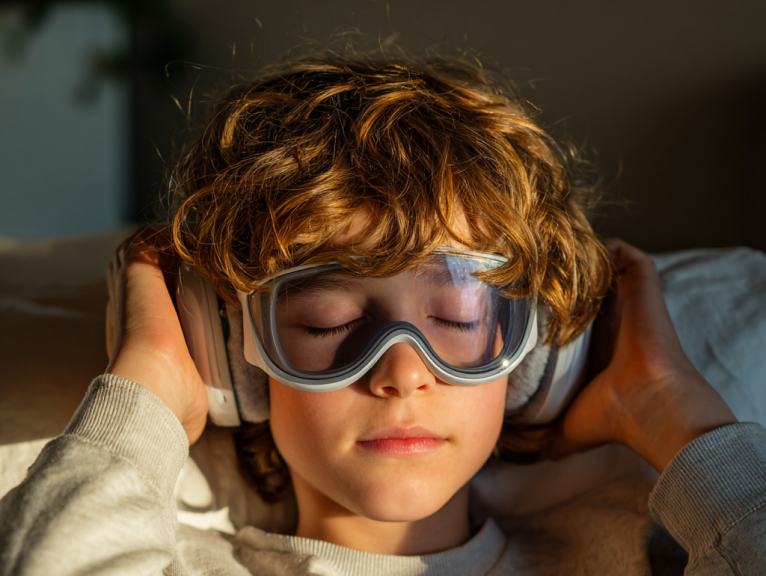
20 Years of Producing the Highest Quality, Most Reliable, and Effective LED mask.
Discover how light therapy supports ADHD treatment by restoring circadian rhythms, boosting brain function, and reducing reliance on medication. Evidence-based strategies and protocols inside.

Attention Deficit Hyperactivity Disorder (ADHD) affects millions of children and adults worldwide, significantly impacting their daily functioning and quality of life. As our understanding of this neurodevelopmental disorder deepens, researchers and clinicians are exploring innovative therapeutic approaches beyond traditional pharmaceutical interventions. Among these emerging treatments, light therapy has shown remarkable promise as a non-invasive, side-effect-free approach to managing ADHD symptoms.
ADHD is characterized by persistent patterns of inattention, hyperactivity, and impulsivity that interfere with functioning and development. These core symptoms are often accompanied by executive function deficits, emotional dysregulation, and sleep disturbances. While traditional stimulant medications have proven effective for many patients, they may cause significant side effects including appetite suppression, sleep disturbances, mood swings, and growth concerns in children.
Perhaps most importantly, research has revealed that individuals with ADHD frequently experience circadian rhythm disruptions. Studies show that delayed sleep timing (circadian phase delay) predicts ADHD symptom severity, with patients often exhibiting delayed sleep-wake cycles, difficulty falling asleep, morning awakening challenges, and abnormal patterns of daytime alertness. This circadian misalignment not only exacerbates core ADHD symptoms but also impacts cognitive function and emotional stability.
Light therapy, particularly Bright Light Therapy (BLT), works by regulating the body's biological clock through controlled exposure to specific wavelengths and intensities of light. When light of appropriate parameters reaches the retina, it suppresses melatonin production by the pineal gland while promoting serotonin synthesis, effectively resynchronizing the circadian rhythm system.
Recent advances in transcranial photobiomodulation (t-PBM) have introduced another dimension to light therapy applications. Near-infrared light therapy activates cytochrome c oxidase in the mitochondrial respiratory chain, thereby enhancing ATP synthesis and providing direct neurobiological benefits including:
Multiple clinical studies provide compelling evidence for the efficacy of light therapy in ADHD management:
A groundbreaking open trial published in the Journal of Clinical Psychiatry demonstrated significant improvements in ADHD symptoms following three weeks of morning bright light treatment (10,000 lux, 30 minutes) in adults with ADHD. The strongest correlate of improvement in core ADHD pathology was a phase advance in circadian preference rather than alleviation of comorbid seasonal affective disorder, indicating that light therapy's benefits for ADHD are primarily mediated through circadian rhythm regulation mechanisms.
A pivotal pilot study published in the Journal of Psychiatric Research specifically examined the relationship between circadian phase correction and ADHD symptom improvement. Participants with ADHD underwent 2-weeks of 30-min morning 10,000-lux BLT beginning 3 hours after mid-sleep time, with results showing that correcting delayed circadian phase directly predicted symptom improvement.
A large-scale randomized controlled trial is currently comparing bright light therapy with physical exercise in preventing comorbid depression and obesity in ADHD patients. This represents the first RCT to establish feasibility and efficacy of these interventions targeting the prevention of co-morbid conditions in ADHD.
Recent case studies published in the Journal of BLyehavioral and Brain Science have explored the efficacy of transcranial photobiomodulation for ADHD. The treatment, known as transcranial photobiomodulation (tPBM) delivers near-infrared to infrared light to the brain tissue through the scalp and skull, showing promise for improving attention and working memory.
Neuroimaging studies suggest that light therapy may improve cognitive function in ADHD patients through several mechanisms:
Based on current research evidence, optimal ADHD light therapy protocols include:
Bright Light Therapy Protocol:
LED/t-PBM Light Therapy Protocol:
Light therapy protocols should be individualized based on patient-specific factors:
Compared to traditional pharmaceutical treatments, light therapy offers significant safety advantages:
Modern light therapy devices continue to evolve, providing better treatment options for ADHD:
Light therapy demonstrates optimal effectiveness when integrated into comprehensive ADHD treatment approaches:
Light therapy can serve as an effective complement to medication therapy, potentially reducing pharmaceutical dependence:
The field of ADHD light therapy continues to evolve with several promising research areas:
Healthcare providers considering light therapy for ADHD patients should follow evidence-based guidelines:
Successful implementation of light therapy for ADHD requires careful attention to practical considerations:
The efficacy and safety of light therapy for ADHD depend significantly on the quality of medical devices used. Professional-grade light therapy equipment should meet stringent regulatory standards:
Light therapy presents an attractive economic proposition for healthcare systems:
The advancement of ADHD light therapy requires international research collaboration:
Light therapy represents a paradigm shift in ADHD treatment, offering a scientifically-grounded, non-invasive alternative to traditional pharmaceutical approaches. Through regulation of circadian rhythms, enhancement of neural function, and improvement of cognitive capabilities, light therapy addresses multiple aspects of ADHD pathophysiology while providing patients with a safe, well-tolerated treatment option.
The growing body of clinical evidence, including studies published in prestigious journals like the Journal of Clinical Psychiatry and Journal of Psychiatric Research, demonstrates that light therapy can produce meaningful improvements in ADHD symptoms. As our understanding of the underlying mechanisms continues to evolve, and as technology advances enable more sophisticated treatment delivery systems, light therapy is poised to become an increasingly important component of comprehensive ADHD care.
For patients, families, and healthcare providers, light therapy offers hope for a brighter future – one where the burden of ADHD can be effectively managed through the healing power of light. With continued research, technological innovation, and clinical implementation, light therapy has the potential to transform the lives of millions affected by this challenging but manageable condition.
The commitment of companies like Kaiyan Medical to developing high-quality, FDA-approved light therapy devices ensures that this innovative treatment approach will continue to be accessible, reliable, and effective for those who need it most. Through rigorous research, clinical validation, and technological excellence, the future of ADHD treatment is indeed illuminated by the promise of therapeutic light.
This article is written for medical professionals and is based on current scientific research. All treatment decisions should be made under the guidance of qualified healthcare providers. For the latest research updates and clinical protocols, consult peer-reviewed medical literature and professional medical organizations.
